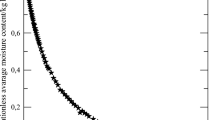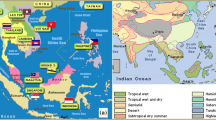Abstract
This paper presents the thermal modelling and experimental validation of a walk-in type solar tunnel dryer for drying of fenugreek leaves in Indian climatic conditions. The tunnel dryer is a metallic framed structure covered with a 200-μm ultraviolet stabilized plastic sheet. This dryer has a 5 × 3.75-m floor area and is 1.75 m in height. Its loading capacity of leafy vegetables is about 100 kg. The dryer works on natural convection mode, and maximum temperature attained during experiment was 58.11 °C. Fenugreek leaves were dried from moisture content of 89 % (wb) to 9 % (wb) in 17 solar hours under typical Indian climatic conditions. Experimental energy and exergy efficiency of drying chamber ranged from 2.72 to 28.01 % and 69.43 to 90.76 % respectively. The mathematical modelling was programmed in MATLAB version 2010a. The theoretical results agreed well with experiential data for drying of fenugreek leaves. Some additional parametric studies and payback period analysis are presented.







Similar content being viewed by others
References
Muhlbauer, W. (1981). Solar drying of agricultural products’, in Proc. Reg. Workshop Rural Development Technology, 25–29 May, Korea Advanced Institute of Science and Technology, Seoul 415–433.
Garg, H. P., & Kumar, R. (1998). Studies on semi-cylindrical solar tunnel dryers: year round collector performance. Int. J. Energ. Res., 22, 1381–1395.
Sarasavadia, P. N., et al. (1999). Drying behaviour of brined onion slices. Journal of Food Engineering, 40, 219–226.
Kothari, S., et al. (2009). Performance evaluation of exhaust air recirculation system of mixed mode solar dryer for drying of onion flakes. International Journal of Renewal Energy Technology, 1, 29–41.
Cakmak, G., & Yıldız, C. (2011). The prediction of seedy grape drying rate using a neural network method. Computer Electronic Agriculture, 75, 132–138.
Zomorodian, A., et al. (2007). Optimization and evaluation of a semi-continuous solar dryer for cereals (rice, etc.). Desalination, 209, 129–135.
Hernando, E. C., et al. (2011). Development of model based sensors for the supervision of a solar dryer. Computer Electronic Agriculture, 78, 167–175.
Maskan, M. F., & Gogus, F. (1998). Sorption isotherms and drying characteristics of mulberry (Morus alba). Journal of Food Engineering, 37, 437–449.
Akpinar, E. K., et al. (2003). Modeling and experimental study on drying of apple slices in a convective cyclone dryer. Journal of Food Process Engineering, 26, 515–541.
Henderson S. M. (1974). Progress in developing the thin layer drying equation, Trans. ASAE, 1167–1172.
Verma, L. R., et al. (1985). Effects of drying air parameters on rice drying models. T. ASAE, 28, 296–301.
Eldeen, Y. I. S., et al. (1980). A model for ear corn drying, Trans. ASAE, 23, 1261–1271.
Diamante, L. M., & Munro, P. A. (1993). Mathematical modelling of thin layer solar drying of sweet potato slices. Solid Energy, 51, 271–276.
Ozdemir, M., & Devres, Y. O. (1999). The thin layer drying characteristics of hazelnuts during roasting. Journal of Food Engineering, 42, 225–233.
Midilli, A., et al. (2002). A new model for single layer drying of some vegetables. Drying Technology, 20, 1503–1513.
Togrul, I. T., & Pehlivan, D. (2003). Modeling of drying kinetics of single apricot. Journal of Food Engineering, 58, 23–32.
Akpinar, E. K. (2006). Mathematical modelling of thin layer drying process under open sun of some aromatic plants. Journal of Food Engineering, 77, 864–870.
Akpinar, E. K., et al. (2006). Modelling of thin layer drying of parsley leaves in a convective dryer and under open sun. Journal of Food Engineering, 75, 308–315.
Yaldiz, O., & Ertekin, C. (2011). Thin layer solar drying of some vegetables. Drying Technology, 19, 583–596.
Garavand, A. T., Rafiee, S., Keyhani, A., et al. (2011). Mathematical modeling of thin layer drying kinetics of tomato influence of air dryer conditions. International Transactions Journal Engg. Mangt. & Application Science & Technology, 2, 147–160.
Daoud, K., & Abchiche, H. (2008). Hydrodynamic study of the granular flow in the solar dryer. Desalination, 220, 661–668.
Garg, R., et al. (1998). Simulation model of the thermal performance of a natural convection-type solar tunnel dryer. International Journal of Energ Research, 22(1998), 1165–1177.
Garg, H. P., & Kumar, R. (2000). Studies on semi-cylindrical solar tunnel dryers: thermal performance of collector. Applied Thermal Engineering, 20, 115–131.
Bala, B. K., et al. (2003). Solar drying of pineapple using solar tunnel drier. Renew Energy, 28, 183–190.
Condorı, M., & Saravia, L. (2003). Analytical model for the performance of the tunnel-type greenhouse drier. Renew Energy, 28, 467–485.
Hossain, M. A., et al. (2005). Optimisation of solar tunnel drier for drying of chilli without color loss. Renew Energy, 30, 729–742.
Sacilik, K., et al. (2006). Mathematical modelling of solar tunnel drying of thin layer organic tomato. Journal of Food Engineering, 73, 231–238.
Janjai, S., et al. (2009). Solar drying of peeled longan using a side loading type solar tunnel dryer: experimental and simulated performance. Drying Technology, 27, 595–605.
Srisittipokakun, N., et al. (2012). Solar drying of Andrographis paniculata using a parabolicshaped solar tunnel dryer. Procedia Engineering, 32, 839–846.
Eltiet, S. A., et al. (2007). Drying chamber performance of V-groove forced convective solar dryer. Desalination, 209, 151–155.
Schirmer, P., et al. (1996). Experimental investigation of the performance of the solar tunnel dryer for drying bananas. Renew Energy, 7, 119–129.
Hossain, M. A., & Bala, B. K. (2007). Drying of hot chilli using solar tunnel drier. Solid Energy, 81, 85–92.
Sevda, M. S., & Rathore, N. S. (2009). Experimental investigation of the performance of the solar tunnel dryer for drying aonla pulp. International Journal of Global Energy, 31, 183–192.
Rathore, N. S., & Panwar, N. L. (2010). Experimental studies on hemi cylindrical walk-in type solar tunnel dryer for grape drying. Applied Energy, 87, 2764–2767.
Rathore, N. S., & Panwar, N. L. (2011). Design and development of energy efficient solar tunnel dryer for industrial drying. Clean Technologies and Environmental Policy, 13, 125–132.
Janjai, S., et al. (2011). A large-scale solar greenhouse dryer using polycarbonate cover: modeling and testing in a tropical environment of Lao People’s democratic republic. Renew Energy, 36, 1053–1062.
Intawee, P., & Janjai, S. (2011). Performance evaluation of a large-scale polyethylene covered greenhouse solar dryer. International Energy Journal, 12, 39–52.
Sharma, R. D. (1986). Effect of fenugreek seeds and leaves on blood glucose and serum insulin responses in human subjects. Nutrition Research, 6, 1353–1364.
Devi, B. A., et al. (2003). Supplementation of fenugreek leaves to diabetic rats, effect on carbohydrate metabolic enzymes in diabetic liver and kidney. Phytotherapy Research, 17, 1231–1233.
Ekechukwu, O. V., & Norton, B. (1997). Design and measured performance of a solar chimney for natural circulation solar energy dryers. Renew Energy, 10, 81–90.
Diffie, J. A., & Beckman, W. A. (1991). Solar engineering of thermal processes. New York: Wiley.
Watmuff, J. H., et al. (1977). Solar and wind induced external coefficients for solar collectors. Comples, 2, 56.
Kays, W. M., & Crawford, M. F. (1980). Convective heat and mass transfer. New York: McGraw Hill.
Weiss, A. (1977). Algorithms for the calculation of moist air properties on a hand calculator. Transactions of ASAE, 20, 1133–1136.
Singh, O. K., Kaushik, S. C. (2012). Variables influencing the exergy based performance of a Steam Power Plant, Int J Green Energ (Article in press) DOI: 10.1080/15435075.2011.653847
Janjai, S. (2012). A greenhouse type solar dryer for small-scale dried food industries: development and dissemination. International Journalof Energy Environment, 3, 383–398.
Dincer, I. (2000). Thermodynamic, exergy and environmental impact. Energy Source, 22, 723–732.
Dincer, I., & Cengel, A. Y. (2001). Energy, entropy and exergy concepts and their roles in thermal engineering. Entropy-International Journal, 3, 116–149.
Midilli, A., & Kucuk, H. (2003). Energy and exergy analyses of solar drying process of pistachio. Energy, 28, 539–556.
Bayrak, M., et al. (2003). Energy and Exergy analyses of sugar production stages. International Journal of Energy Research, 27, 989–1001.
Gupta, M. K., & Kaushik, S. C. (2009). Performance evaluation of solar air heater for various artificial roughness geometry based on energy, effective and exergy efficiencies. Renew Energy, 34, 465–476.
Panwar, N. L., et al. (2012). A review on energy and exergy analysis of solar dying systems. Renewable and Sustainable Energy Reviews, 16, 2812–2819.
Akpinar, E. K. (2011). Drying of parsley leaves in a solar dryer and under open sun: modeling, energy and exergy aspects. Journal of Food Process Engineering, 34, 27–48.
Holman, J. P. (2010). Experimental methods for engineers, Tata McGraw Hill Education Private Limited, India
Acknowledgments
Authors are thankful to Prof. Serm Janjai, Solar Energy Research Laboratory, Department of Physics, Faculty of Science, Silpakorn University, Nakhon Pathom, Thailand, for providing the base model used in present study.
Author information
Authors and Affiliations
Corresponding author
Rights and permissions
About this article
Cite this article
Panwar, N.L., Rathore, N.S. & Wadhawan, N. Thermal Modelling and Experimental Validation of a Walk-in Type Solar Tunnel Dryer for Drying Fenugreek Leaves (Methi) in Indian Climate. Environ Model Assess 20, 211–223 (2015). https://doi.org/10.1007/s10666-014-9427-1
Received:
Accepted:
Published:
Issue Date:
DOI: https://doi.org/10.1007/s10666-014-9427-1




